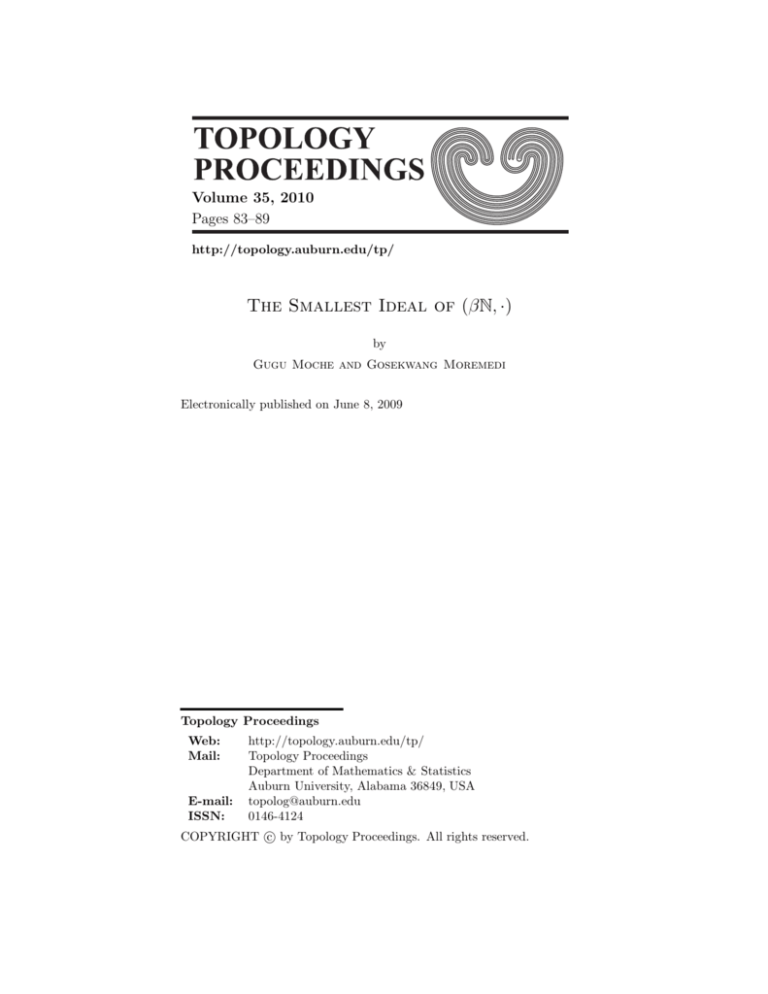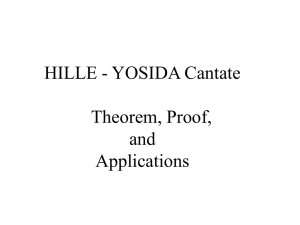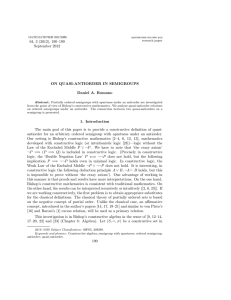
Volume 35, 2010
Pages 83–89
http://topology.auburn.edu/tp/
The Smallest Ideal of (βN, ·)
by
Gugu Moche and Gosekwang Moremedi
Electronically published on June 8, 2009
Topology Proceedings
Web:
Mail:
E-mail:
ISSN:
http://topology.auburn.edu/tp/
Topology Proceedings
Department of Mathematics & Statistics
Auburn University, Alabama 36849, USA
topolog@auburn.edu
0146-4124
c by Topology Proceedings. All rights reserved.
COPYRIGHT http://topology.auburn.edu/tp/
TOPOLOGY
PROCEEDINGS
Volume 35 (2010)
Pages 83-89
E-Published on June 8, 2009
THE SMALLEST IDEAL OF (β N, ·)
GUGU MOCHE AND GOSEKWANG MOREMEDI
Abstract. In this paper we are concerned with the semigroup (β N, +). As with any compact (Hausdorff) right topological semigroup, (β N, +) has a smallest two sided ideal
K(β N, +). Known results about this ideal will be presented
in Section 2.
By way of contrast, not much has been known about the
smallest ideal of (β N, ·). In Theorem 3.2 in Section 3, we will
present one such result. In particular, in this theorem, we
will show that each maximal subgroup of K(β N, ·) contains a
copy of the free group on 2c generators.
1. Introduction
The structure of K(βS) yields many significant consequences in
that part of combinatorics known as Ramsey Theory. An example of such application is provided by the Finite Sums Theorem.
This theorem states that whenever N is partitioned into finitely
many classes (or finitely colored), there is a sequence hxn i∞
n=1 with
F S(hxn i∞
)
contained
in
one
class
(or
monochrome).
(Here
n=1
P
FS(hxn i∞
)
=
{
x
:
F
is
a
finite
nonempty
subset
of
N}).
n=1
n∈F n
The initial proof did not use β N and was complex. A simpler proof
using the algebraic structure of β N was provided in 1975 by Galvin
and Glazer.
2000 Mathematics Subject Classification. 22A15, 54D35.
Key words and phrases. Topological semigroups, Stone-Čech compactification of semigroups, smallest ideal of β N.
c
2009
Topology Proceedings.
83
84
GUGU MOCHE AND GOSEKWANG MOREMEDI
Given a discrete semigroup (S,+), one can extend the operation
+ to βS, the Stone-Čech compactification of S, so that (βS, +) becomes a right topological semigroup with S contained in its topological center. That is, for each p ∈ βS, the function ρp : βS → βS,
defined by ρp(q) = q +p, is continuous and for each x ∈ S, the function λx : βS → βS defined by λx(p) = x + p is continuous. We
take βS to be the set of ultrafilters on S and identify the principal
ultrafilters with the points of βS.
To explain the topology of βS, choose sets of the form A =
{p ∈ βS : A ∈ p}, where A ⊆ S, as a base for the open sets.
In the semigroup (βS, +), given p,q ∈ βS and A ⊆ S, one has
that A ∈ p + q if and only if {x ∈ S : −x + A ∈ q} ∈ p where
−x + A = {s ∈ S : x + s ∈ A}. It should be noted that even though
we are denoting the operation by + because we will be concerned
with the semigroup (β N, +), (βS, +) is almost never commutative.
Since we are concerned with the semigroup (β N, +), as with any
compact (Hausdorff) right topological semigroup, (β N, +) has a
smallest two sided ideal K(β N, +). Known results about this ideal
will be presented in Section 2.
By way of contrast, not much has been known about the smallest
ideal of (β N, ·). In Section 3 we will present one such result. In
Theorem 3.2, we will show that each maximal subgroup of K(β N, ·)
contains a copy of the free group on 2c generators. It should be
noted that a more general version of of this theorem was obtained
independently in [5, Theorem 4.17].
Acknowledgement
We thank Prof. Mamokghethi Setati, the Executive Dean of the
College of Science, Engineering, and Technology at the University
of South Africa for creating a working environment that promotes
research. The second author acknowledges the NRF (South Africa)
for financial support through grant TTK2006062800025.
2. Definitions and Preliminary Results
In this section we review some well-known definitions and facts
that we shall use in Section 3.
THE SMALLEST IDEAL OF (β N, ·)
85
Notation.
(a) Given a set A, Pf (A) = {F : ∅ 6= F ⊆ A and F is finite }.
(b) NN = {f : f : N → N}.
(c) [A]k = {B ⊆ A : |B| = k}.
Definition 2.1. Let (S, +) be a semigroup.
(a) L is a left ideal of S if and only if ∅ 6= L ⊆ S and S +L ⊆ L.
(b) R is a right ideal of S if and only if ∅ 6= R ⊆ S and R + S ⊆
R.
(c) I is an ideal of S if and only if I is both a left ideal and a
right ideal of S.
Definition 2.2. Let (S, +) be a semigroup.
(a) L is a minimal left ideal of S if and only if L is a left ideal
of S and whenever J is a left ideal of S and J ⊆ L one has
J = L.
(b) R is a minimal right ideal of S if and only if R is a right
ideal of S and whenever J is a right ideal of S and J ⊆ R
one has J = L.
(c) S is left simple if and only if S is a minimal left ideal of S.
(d) S is right simple if and only if S is a minimal right ideal of
S.
(e) S is simple if and only if the only ideal of S is S.
The following theorems give characterizations of the smallest two
sided ideal of a compact right topological semigroup.
Theorem 2.3. If S is any compact right topological semigroup,
then S has a smallest two sided ideal K(S) which satisfies the following statements.
S
(a) K(S) = S{R : R is a minimal right ideal of S}.
(b) K(S) = {L : L is a minimal right ideal of S}.
(c) If L is a minimal left ideal and R is a minimal right ideal,
then L ∩ R is a maximal subgroup of K(S) and all maximal
subgroups of K(S) are of this form.
(d) All maximal subgroups of S contained in K(S) are isomorphic.
(e) All maximal subgroups of S contained in in the same minimal right ideal are isomorphic and homeomorphic via the
same function.
86
GUGU MOCHE AND GOSEKWANG MOREMEDI
Proof. [8, Theorems 1.64, 2.8, and 2.11].
Theorem 2.4. Let S be a semigroup with a minimal left ideal L,
and a minimal right ideal R. Then RL = R ∩ L is a group and if e
denotes the identity of RL, then R = eS, L = Se and RL = eSe.
Proof. Clearly, RL ⊆ R ∩ L. Also, RL is a semigroup since
(RL)(RL) = R(LRL) ⊆ RL. Let s ∈ RL. Then s ∈ L, so Ls = L
[1, Theorem 1.2.4(ii)] and hence RLs = RL. Similarly, sRL = RL.
Therefore, RL is left and right simple and so must be a group [1,
Theorem 1.1.17]. Furthermore, since e ∈ L ∩ R, we have L = Se
and R = eS, hence RL = eSSe ⊆ eSe = Re ⊆ RL and therefore
RL = eSe. Since eS ∩ Se ⊆ eSe, RL = R ∩ L.
In the case of K(β N, +) much is known about the smallest ideal.
In particular, we have, where c is the cardinality of the continuum:
Theorem 2.5. In K(β N, +)
(a) there are 2c minimal left ideals;
(b) there are 2c minimal right ideals; and
(c) each maximal group contains a copy of the free group on 2c
generators.
Proof. [8, Theorem 6.9 and Corollary 7.37].
By way of contrast, not much has been known about the smallest
ideal of (β N, ·). In Section 3 we will present results on this smallest
ideal.
3. Smallest Ideal of (β N, ·)
The following Lemma was presented in [12, Lemma 1.2] with few
details in the proof.
Lemma 3.1. Let S and T be compact right topological semigroups
and let φ : S → T be a surjective homomorphism. If A ⊆ S is
a mimimal left ideal, minimal right ideal, or maximal subgroup of
K(S), then φ[A] is the corresponding object in T .
Proof. Let φ : S → T be a surjective homomorphism. Suppose A is
a left ideal of S. We claim that φ[A] is a left ideal of T . Let x ∈ φ[A]
and y ∈ T . It suffices to show that y · x ∈ φ[A]. Since φ is surjective
pick y 0 ∈ S such that y = φ(y 0). Also, x ∈ φ[A] implies there is some
x0 ∈ A such that x = φ(x0). So, yx = φ(y 0 ) · φ(x0 ) = φ(y 0x0 ) ∈ φ[A]
since y 0 x0 ∈ A. Thus, φ[A] is a left ideal of T .
THE SMALLEST IDEAL OF (β N, ·)
87
Now we shall show that if A is a minimal left ideal of S, then
φ[A] is minimal in T . From above φ[A] is a left ideal of T . Also
since Sa = A for all a ∈ A, T t = φ[A] for all t ∈ φ[A]. Therefore
by Theorem 2.3a φ[A] is minimal.
Notice that the topological hypotheses were not used in the proof
that the image of a minimal left ideal is a minimal left ideal. Thus,
by a right-left switch, we have that if A is a minimal right ideal of
S, then φ[A] is a minimal right ideal of T .
We now show that if A is a maximal group in S then φ[A] is a
maximal group in T . Pick by Theorem 2.3(c) a minimal left ideal
L and a minimal right ideal R of S such that A = L ∩ R. Then
φ[L] is a minimal left ideal of T and φ[R] is a minimal right ideal
of T , and so by Theorem 2.3(c), φ[L] ∩ φ[R] is a maximal subgroup
of K(T ). Let e be the identity of A. Then φ(e) ∈ φ[L] ∩ φ[R] ⊆
K(T ). By Theorem 2.4, A = eSe and the maximal group with
φ(e) as identity in φ(e)T φ(e). Since φ is surjective, we have that
φ[A] = φ[eSe] = φ(e)φ[S]φ(e) = φ(e)T φ(e).
We saw in Theorem 2.5 some of the many things that are known
about the structure of K(β N, +). Much less is known about the
structure of K(β N, ·), and this is a motivating factor behind the
research presented here. The following result is new. As mentioned
earlier, a more general version of this theorem was obtained independently in [13, Theorem 4.17].
Theorem 3.2. Each maximal subgroup of K(β N, ·) contains a copy
of the free group on 2c generators.
Proof. Let ω = N ∪ {0}. Define the map φ : N → ω by φ(n) = k
where n = 2k · (2r + 1). (Thus φ(n) is the number of factors of 2
in n.) Then φ is a surjective homomorphism from (N, ·) to (ω, +)
e : (β N, ·) → (βω, +) is
and consequently the continuous extension φ
e N] is a compact
a homomorphism by [8, Corollary 4.22]. Since φ[β
subset of βω containing ω, we have that φe is surjective.
Let A be a maximal group in K(β N, ·). Then by Lemma 2.6,
e
φ[A] is a maximal group in K(βω, +).
Let G be the free group on the sequence hbiii<2c of generators
and let B = {bi : i < 2c }. Then there is an injective homomorphism
e
τ : G → φ[A]
by Theorem 2.5(c). For each i < 2c , pick ai ∈ A such
e i ) = τ (bi). Define µ : B → A by µ(bi ) = ai for all i < 2c .
that φ(a
88
GUGU MOCHE AND GOSEKWANG MOREMEDI
By the universal extension property of free groups [8, Lemma 1.22],
there is a unique homomorphism γ : G → A such that for each
i < 2c , γ(bi) = µ(bi ) = ai .
We claim that the above diagram commutes. For i fixed, φe γ(bi) =
e i ) = τ (bi). Thus φe ◦ γ is a homorphism which agrees with τ on
φ(a
B so, again by [8, Lemma 1.22], we have that φe ◦ γ = τ .
Let e be the identity of G, let α be the identity of A, and let δ be
e
the identity of φ[A].
To complete the proof we show that the kernel
of γ is {e}. To this end, let x ∈ G and assume that γ(x) = α. Then
e
τ (x) = φe γ(x) = φ(α)
= δ and so x = e because τ is injective.
It should be noticed that the function φ : (N, ·) → (ω, +) defined
as in the previous proof by φ(n) = k, where n = 2k · (2r + 1), is
rather badly not one to one.
References
[1] J. Berglund, H. Junghenn, and P. Milnes, Analysis on semigroups, J. Wiley
& Sons., New York, 1989.
[2] A. Blass, Orderings of ultrafilters, Thesis, Harvard University, Cambridge,
Mass., 1970.
[3] A. Blass, Amalgamation of nonstandard models of arithmetic, J. Symbolic
Logic, 42(1977), 372-385.
[4] W. Comfort and S. Negrepontis, The theory of ultrafilters, Springer-Verlag,
Berlin, 1974.
[5] M. Daguenet, Rapport entre l’ensemble des ultrafiltres admettant un ultrafiltre donné pour image et l’ensemble des images de cet ultrafiltre, Comment. Math. Univ. Carolinae 16(1975), 99-113.
[6] R. Graham, B. Rothschild, and J. Spencer, Ramsey Theory, Wiley, New
York, 1990.
[7] N. Hindman, Preimages of points under the natural map from β(N × N) to
β N × β N, Proc. Amer. Math. Soc. 37(1973), 603-608.
[8] N. Hindman and D. Strauss, Algebra in the Stone-Čech compactification,
W. de Gruyter & Co., Berlin, 1998.
[9] F. Ramsey, On a problem of formal logic, Proc. London Math. Soc.
30(1930), 264-286.
THE SMALLEST IDEAL OF (β N, ·)
89
[10] W. Rudin, Homogeneity problems in the theory of Čech compactifications,
Duke Math. J. 23(1966), 409-419.
[11] S. Shelah, Proper forcing, Springer-Verlag, Berlin, 1982.
[12] N. Hindman and J. Pym, Free and semigroups in β N, Semigroup Forum
30(1984), 177-193
[13] S. Ferri, N. Hindman, and D. Strauss, Digital representation of semigroups
and groups, Semigroup Forum 77(2008), 36-63
E-mail address: mocheiog@unisa.ac.za
E-mail address: moremgm@unisa.ac.za
Department of Mathematical Sciences, University of South Africa,
P.O.Box 392, 0003, South Africa












